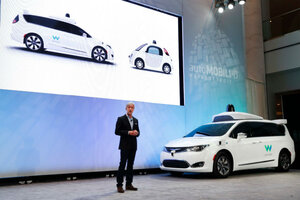Google launches self-driving minivans: are autonomous cars inching closer to mass movement?
Over the past few years, autonomous vehicle technology has made exponential leaps forward. But are they ready to hit roads across the United States?

John Krafcik, the chief executive officer of Waymo Inc., the autonomous vehicle company created by Google's parent company, introduces a Chrysler Pacifica hybrid outfitted with Waymo's own suite of sensors and radar at the North American International Auto Show in Detroit on Sunday.
Paul Sancya/AP
Self-driving cars may be one step closer to taking over the roads across the United States – and now, whole families can join in.
Waymo, an independent company that spun off from Google's autonomous vehicle program in December of last year, showed off a new fleet of self-driving minivans to the general public at the North American auto show in Detroit on Sunday. The cars boast a sensor suite, created completely in-house for the first time, that gives the vehicles the ability to drive themselves. The company has announced that they plan to release the cars onto public roads by the end of the month.
As various companies break into the fledgling self-driving market, autonomous vehicles are moving from test sites to streets all over the world. But despite dramatic leaps forward in self-driving technology, some critics have concerns that the enthusiasm for the prospect of self-driving cars may have outpaced the industry's ability to address the technological, legal, and security hurdles that have to be cleared before autonomous vehicles can revolutionize the world's roadways.
Google's self-driving car division began in 2009, with a project to drive ten uninterrupted 100-mile routes without driver assistance. Since then, advances in technology and competition with other companies with their own autonomous vehicle programs, such as Tesla, Lyft, Uber, and even Apple, have led to a sort of corporate arms race to become the face of a new, driverless revolution.
"Although activities surrounding the development of autonomous vehicles have existed ever since the 1920s, there has recently been a significant push by both the automotive and high tech sectors to make these vehicles a reality," writes Alex Wyglinski, an associate professor of electrical and computer engineering at Worcester Polytechnic Institute, in an email to The Christian Science Monitor.
But there are still a number of remaining obstacles for self-driving cars to overcome, technical and otherwise.
Roadways filled with autonomous cars will put life-and-death ethical considerations in the hands of programs, Alice Fischer, a professor of electrical and computer engineering and computer science at the University of New Haven in Connecticut, tells the Monitor via email.
"We anthropomorphize these vehicles," Dr. Fischer writes. "We imagine that they have 'sight' and can 'think.' However, their 'vision' is not like ours and their 'thoughts' are following pre-programmed rules and probabilities."
And while ethical priorities might be programmed into vehicles, ultimately the decisions for what such programs will entail "will all be made to benefit the company that is building and selling the cars," she says.
But corporations with autonomous vehicle divisions bill their vehicles as safer than human-driven cars. According to a September 2016 statement from Google, 94 percent of car accidents in the US are due, at least in part, to human error. The first recorded fatality in a Tesla vehicle utilizing automatic driving mode did, however, result from an error in the operating system's calculations, as the vehicle failed to register a large white truck against the sky. And the rareness of the autonomous vehicles themselves might help account for the low number of accidents, skewing perceptions about their safety.
Still, many are optimistic. In October, the National Highway Traffic Safety Administration (NHTSA), a subsection of the US Department of Transportation, signed on to the remarkable goal of zero traffic deaths in the US by 2046. The 30-year plan to bring the tens of thousands of roadway fatalities every year down to zero might depend on removing human error as a factor in road deaths.
"The estimates of the number of lives that could be saved are grossly speculative, and apply only to the case that all cars are car-bots," Fischer says. "Achieving this goal would require a very large change in state laws – basically, to outlaw real cars."
The prohibition of human operated vehicles presents its own problems, not the least of which is equitable accessibility, Fischer says. Currently, autonomous vehicle equipment is prohibitively expensive for most consumers, and poor families would likely be unable to afford them, even with mass production.
That said, bringing down the price of self-driving cars would likely be a priority for many companies. Waymo's sensor suite in its new autonomous minivans were all made in-house, bringing ring down costs significantly. For instance, sensors worth $75,000 back in 2009 now only cost the company $7,500 to build itself, according to The Verge.
Fischer also notes that "smart" vehicles are extremely hackable and contain a number of unaddressed security risks. Without proper protection, such cars' connectivity could be exploited and even actively controlled by hackers.
But ready or not, autonomous vehicles are coming, says WPI's Dr. Wyglinski.
"With the constantly growing number of companies, partnerships, and activities from both the high tech and automotive sectors investing in autonomous vehicles, it is anticipated we'll see consumer-grade autonomous vehicles on the road within the 2018-2020 timeframe," he says.

